South Pole Ponies
The Forgotten Story of Antarctica’s Meat-Eating Horses
by
CuChullaine O’Reilly FRGS
There is a widespread belief in a warm and comforting story which states the horse is a gentle herbivore which fears predators.
A shocking new book, Deadly Equines, reveals instead that horses terrified our ancestors and are still killing us today. Accounts include stories about the English stallion that eagerly killed and ate the citizens of Lucknow, a French mare that slew Russian soldiers and a Japanese horse who slaughtered samurai.
Unfortunately, the average human being’s daily knowledge of equine nature has diminished to an alarming extent. It has been replaced by a Disney-esque version of events where there is no dark side to nature. This is particularly true in Anglophone countries, where books and films now commonly depict horses in romantic terms.
What has been overlooked is that mankind has known about meat-eating horses for at least four thousand years, during which time horses have consumed nearly two dozen different types of protein, including human flesh, and that these episodes have occurred on every continent, including Antarctica.
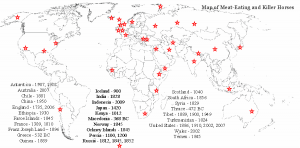
Because of this pervasive equestrian amnesia, the vital role played by meat-eating horses in exploration history has been lost to modern man.
That strange tale began in the late 19th century when Sweden’s most famous explorer and Historical Long Rider, Sven Hedin, reported that Tibetan horses were fed meat in the grassless Himalayan Mountains. Shortly afterwards the celebrated French Long Rider, Gabriel Bonvalot, not only confirmed that these horses, “feed on raw flesh,” he rode them across Tibet in 1889.
Nor was the practice of training horses to eat meat restricted to Tibet or the past.
The first CIA spy to die in action, Douglas MacKiernan, was murdered in 1950, shortly after he rode across the Gobi Desert on a meat-eating horse. And though the last Long Rider to ride one of these strange animals has just died, the Kazakh tribesmen who train these horses recently offered to sell one to England’s modern explorers.
(http://www.thelongridersguild.com/bessac.htm)
While new evidence continues to be uncovered, including how the Bhutanese are still feeding their horses tiger’s fat and yak meat, the most astonishing exploration story has been buried by scholastic neglect under the snows of Antarctica.
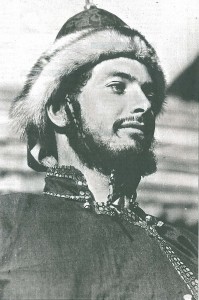
North Pole Horses
While it is now commonly agreed that dog travel in winter conditions is an excellent methodology, abundant evidence demonstrates that this view was not shared by all polar explorers at the beginning of the last century. What has also been overlooked is the simultaneous use of meat-eating horses in trying to reach both the North and South Poles.
Likewise, it is wrong to think that the lack of any equine fodder in the Antarctic interior automatically ruled out horses, as once the explorer moves away from the seal and penguin populations there is also no meat for the dogs. Advocates of dog travel argue that as the expedition journeys further inland, dogs can be sacrificed and fed to their companions. Horses, it was believed, had to rely on grass or grain, brought at great effort from the coast.
Recent discoveries demonstrate instead that a meat-eating horse would have reached the South Pole years before dogs did so, had he not fallen victim to an accident en route.
The decision to incorporate equine strength into Polar exploration was based upon the fact that the Siberian equestrian culture had a centuries-old tradition of winter-time horse travel. Despite having the coldest climate in the northern hemisphere, the Siberians routinely travelled along the great post road which criss-crossed that portion of the Russian empire.
These horses are able to survive because they have specialized hair which has a special core that greatly increases its insulating characteristics. Additional insulation is provided by a sub-dermal layer of fat. Plus, the Siberian horses have the special ability to alter the rate of their respiration, thereby helping them to further adapt to extremes of cold weather. They were even known to function well while being covered in sheets of ice, which actually acted as an insulating agent.
(http://www.thelongridersguild.com/yakuts.htm)
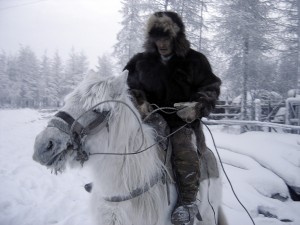
In 1893 a renowned British explorer and Long Rider, Frederick George Jackson, used these remarkable Russian horses to make a 3,000 mile winter crossing of Siberia. Thanks to the success of this expedition, in 1894 Jackson was asked to head an international expedition whose goal was to explore Franz Josef Land, a remote archipelago located north of Russia in the Arctic Ocean.
While Jackson did take dogs, he also brought four Siberian horses with him to explore this inaccessible part of the world, thus setting the stage for a remarkable set of equestrian events which would later conclude in Antarctica.
During Jackson’s journey in Franz Josef Land with his robust horses, it was 30 degrees below zero. Yet he travelled “night and day” for twelve days with a sledge weighing 700 pounds, covering 240 miles along “abominable tracks.”
“And such are the courage and stamina of these hardy little Russian horses that although we had only given them two rests of two hours each during that time they were full of spirit at the end.”
He later writes, “We had travelled 470 miles in seven and a half days; and I think this speaks volumes for the little Russian horses. We had two sledges, and one horse to each sledge; we went at a spanking pace nearly the whole way, yet they trotted into camp as fresh as paint.”
In his book, Jackson recalled how one of these animals, a mare named Brownie, “appears to be doing very well on her miscellaneous diet. In addition to her regular feed of Spratt dog biscuits and hay, she shares the scraps left from our meals with the dogs, and very frequently helps herself to their polar bear meat, and shows a fondness for picking at bird skins lying around the hut.”
(A Thousand Days in the Arctic by Frederick George Jackson, published by Harper & Brothers, New York, 1899.)
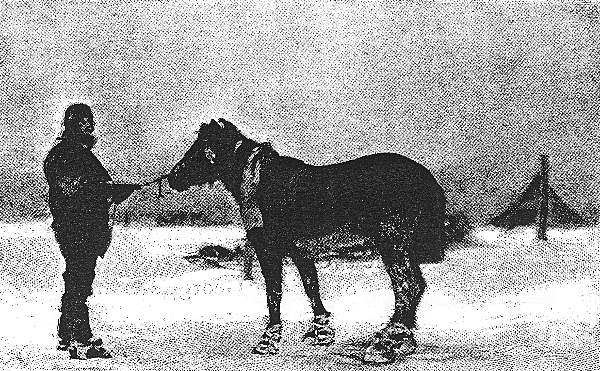
Further horse journeys were to follow.
In 1901 and 1903 two American expeditions also explored the Arctic Circle, both of which used Siberian horses. The second attempt was led by a talented photographer, Anthony Fiala. The equestrian needs of that expedition were handled by veterans of the United States cavalry. These former Indian fighters “led the expedition in mounted drills and exercise rides on the Arctic ice.”
Once again the horses proved to be of immense help.
“The ponies were less troublesome than the dogs and more powerful, dragging loads that astonished us all,” Fiala reported.
(Fighting the Polar Ice by Anthony Fiala, published by Hodder & Stoughton, London, 1907.)

Shackleton and Socks
With these equestrian expeditions serving as a background, and thanks to positive personal experiences with his own meat-eating horses, Jackson encouraged Sir Ernest Shackleton to also use horses in the latter’s bid to reach the South Pole. When the Irish explorer set out to explore Antarctica in 1907, he took ten Manchurian horses, thereby creating an exceptional chain of equestrian events which led from Siberia to the Arctic Circle, and then south to Antarctica.
Though it was later learned that horses will eat seal meat, Shackleton had no way of knowing this prior to his departure. In need of dietary advice, the sailor turned horse explorer turned to the military for assistance. What he found may surprise modern explorers.
It has now been largely forgotten that when the British War Office published Animal Management, a manual prepared by the veterinarian department for His Majesty’s Cavalry and Artillery, the index had a listing for “meat as horse food.”
(Animal Management, Prepared in the Veterinary Department for General Staff, War Office, London, HMSO, 1913.)
Thus the British military high command was aware that horses could consume meat-based rations under certain circumstances. The grassless ice fields of Antarctica would certainly have qualified.
To overcome the horse’s need for bulk grass based feed, Shackleton arranged to purchase ten tons of compressed fodder consisting of oats, bran and chaff. He also took a large stock of corn. Yet upon the advice of the British military establishment, Shackleton decided to enhance his horses’ normal diet with a special meat-based supplement known as “Maujee Ration.” This was a distinctive type of equine pemmican developed at Aldershot, one of England’s most important military establishments.
Sir Ernest recalled, “It consisted of dried beef, carrots, milk, currents and sugar, and was chosen because it provides a large amount of nourishment with comparatively little weight.”
(Heart of the Antarctic by Sir Ernest Shackleton, published by William Heinemann, London, 1909.)
Shackleton set off for the Pole with three comrades and four of the original ten horses. Each of the Manchurian horses pulled a twelve-foot sledge carrying an average of 650 pounds. Like Jackson before him, Shackleton praised his horses.
He wrote, “compared to the dog, the pony is a far more efficient animal, one pony doing the work of at least ten dogs and travelling a further distance in a day……It was trying work for the ponies but they all did splendidly in their own particular way.”
The harsh weather and unforgiving terrain caused the men and horses to struggle alike through the cold and snow. Nevertheless, Shackleton made a startling observation. The horses preferred to eat the meat-based ration rather than the traditional fodder. They even threw corn out of their nosebags, scattering it on the ground, in anger at being denied the Maujee ration.
On November 6, 1908, Shackleton first noted, “They all like the Maujee ration and eat that up before touching their maize.”
A few days later, both men and horses had begun taking special notice of the meat-filled horse food. On November 9, Shackleton wrote, “Tonight we boiled some Maujee ration for the ponies, and they took this feed well. It has a delicious smell and we ourselves would have enjoyed it.”
Because of the dangers and hardships of the journey, three of the gallant horses had to be put down on the outward journey. Nevertheless, Shackleton, his men and the remaining horse, Socks, pressed ever onward towards the South Pole.
On December 3, 1908, at 7 p.m., Sir Ernest Shackleton, his three human companions and Socks pitched camp – and made history.
Because the four men and the sole surviving horse were “tired and hungry, we made a good dinner which included a cupful of Maujee ration as an extra.”
By sharing the Maujee ration, Shackleton and Socks became the first known horse and human to consume meat together, demonstrating that both species are omnivores.
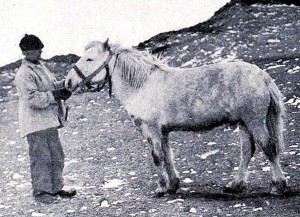
Sadly, neither Shackleton nor Socks gained the South Pole. On December 7, Socks fell into a “black bottomless pit.” Had Socks not died, a meat-eating horse may well have helped Shackleton reach the South Pole.
Shackleton and his men marched on for an additional month, coming remarkably close to their elusive geographic goal. Nevertheless, he had opened the door to a remarkable series of events – a dual equestrian exploration of Antarctica by Great Britain and Germany, both of which also employed meat-eating horses.
If you have additional personal or historical evidence, please contact CuChullaine O’Reilly at
longriders@thelongridersguild.com
To learn more about the “Deadly Equines” research project visit –http://www.lrgaf.org/deadly_equines.htm
To participate in the international discussion regarding “Deadly Equines” visit –
To order the book visit – http://www.barnesandnoble.com/w/deadly-equines-cuchullaine-oreilly/1104580837?ean=9781590480038&itm=1&
CuChullaine O’Reilly is an equestrian explorer, Fellow of the Royal Geographical Society and the Explorers’ Club, one of the Founders of The Long Riders’ Guild, Director of the LRG-AF, publisher of the LRG Press and author of Khyber Knights.
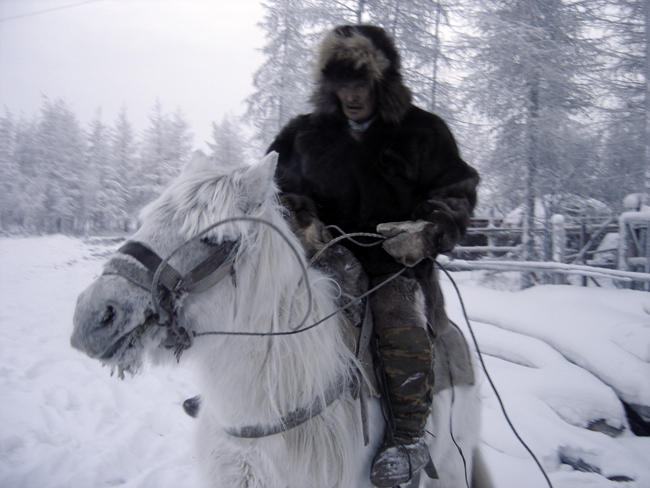
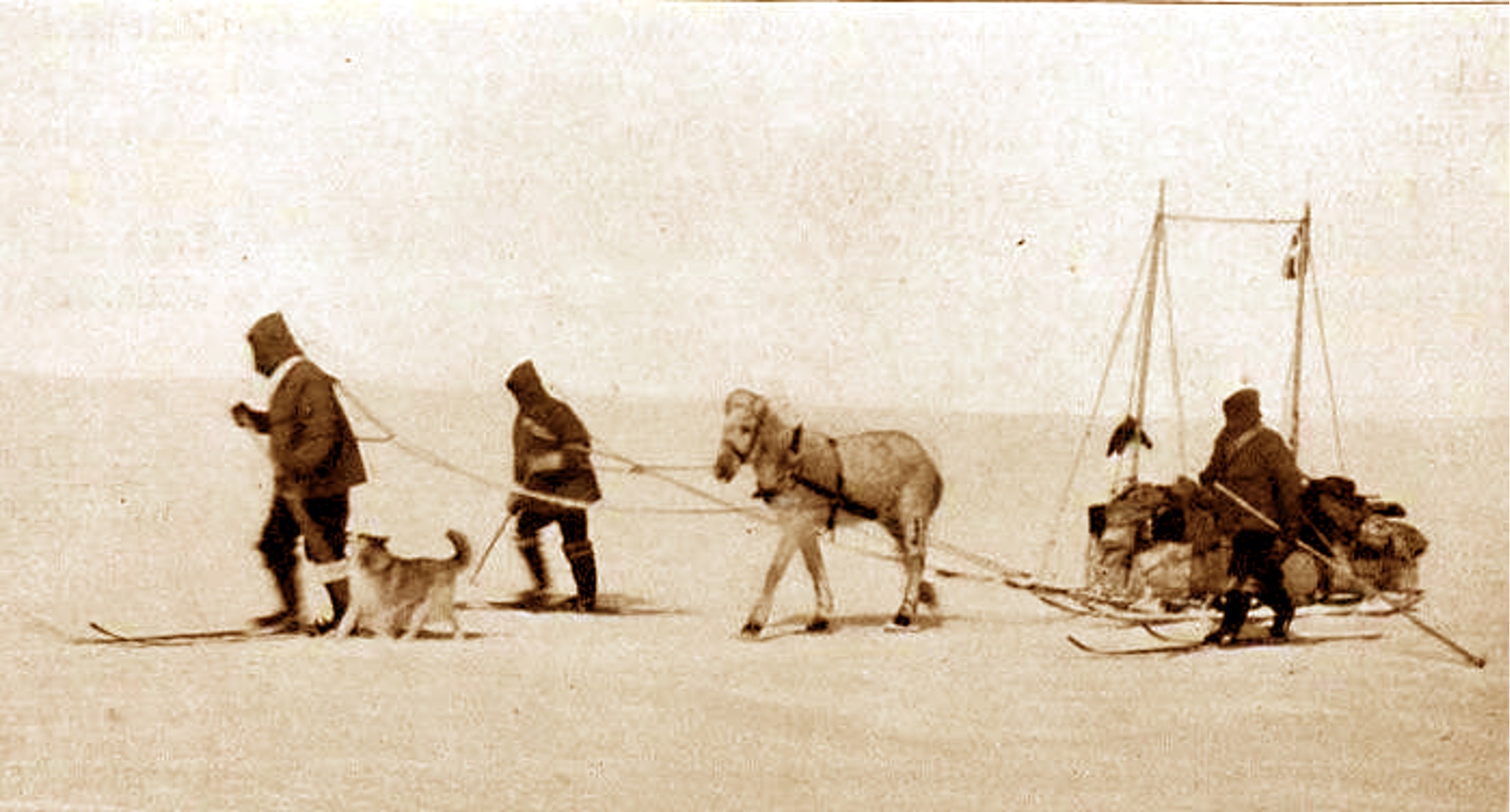
Very interesting article. Never realized horses could eat meat but can see how in some circumstances it would be very beneficial.
Horses can eat meat? That’s a serious discovery, Mr. Strandburg! I really don’t want to put my hand near a horse’s mouth now, so thanks for the warning.
Note:That was NOT sarcastic.
I was very surprised when my horse took a McDonald’s cheese burger right out of my hand, and ate it up. I guess a horse will eat what it can get !
Very interesting article who knew, wow!
What an interesting read. Will get the book. Interesting fellow you are!
Why not eat meat. Its energy in a smaller package. As a horse crazy kid I read book about Arabian horses that said the horses were fed dry fish and eggs on long journeys across the desert. And, I have had horses that will eat anything I eat; hamburgers, BBQ sandwiches, beer,etc. So why not meat. Its common practice now days to add fat supplements to feed, back then the fat that was used I’m sure, was in the form of animal fat. If we can digest it I’m sure they can too. We are herbivores too; according to some.
Totally rediculous how you started out your article with them being “vicious and still eating man today”.. not ONCE in your story did you show that a horse even ate a PERSON nor did it ever say that the horse ATTACKED for their meat based meals.. it was all how the HUMANS produced and FED the horses this product. Having a long history with horses training, breeding, showing, etc I can tell you it’s RARE when you have a “mean” horse let alone one that attacks you to EAT you…. sorry it’s a little out there to imply horses are “prey” animals when they are indeed not.
Dear Hillary,
CuChullaine O’Reilly of the Long Riders’ Guild here.
I am responding to your scepticism regarding the information connected to the “Deadly Equines” project. http://www.lrgaf.org/deadly_equines.htm
Allow me to share information which I hope will be of use.
The first point is that the primary focus of Mikael Strandberg’s blog is the study of exploration’s history, practice and future. I was therefore required to edit a tremendous amount of purely equestrian material from the book “Deadly Equines” and present only a small percentage which was directly connected to the use of horses in early polar exploration.
Since the “Deadly Equines” book was released, knowledge of meat-eating polar ponies has again been expanded by the discovery that in 1914 and 1930 Danish polar explorers also fed their horses a special meat-based meal. This protein diet was created by Denmark’s leading equine nutritional expert, Professor Harald Goldschmidt. Like the polar exploration horses used by Sir Ernest Shackleton, the Danish animals suffered no negative effects from this expansion of their traditional diet.
While wishing to share this polar equine exploration news with Mikael’s readers, I apologize if in doing so I inadvertently neglected to adequately explain the full nature of this complex equine project.
I think it is important to note that I had no desire to investigate this grisly topic. It came about while I was undertaking research for the “Encyclopaedia of Equestrian Exploration,” which I am currently writing. While studying what Long Riders had fed their horses over the ages, I uncovered repeated incidents of explorers who had either introduced some type of meat into their horses’ diet or came into contact with ancient equestrian cultures which routinely fed their horses meat.
One such example happened in 1950 when Douglas MacKiernan became the first CIA spy to die in action. He was killed in Tibet, after having ridden a specially trained Kazakh meat-eating horse across the Takla Makan desert. In November, 1954, National Geographic magazine reported that a large section of the Kazakh tribe had fled the advancing Chinese communist army by escaping into India on meat-eating horses. Apparently the Nat Geo editors saw the words, “meat-eating horses” but, like many people today, could not grasp the reality.
No matter, as “Deadly Equines” was about to begin the printing process, it was halted at the last minute when startling last minute evidence arrived – again linked to the Kazakh tribe.
Renowned British explorer John Hare wrote to say that he had uncovered evidence that knowledge of meat-eating horses had never disappeared among these tribal riders.
”On my recent trip I travelled with four Kazakhs, all of whom are related to the Kazakhs who completed the Gobi crossing. I asked them if they had had experience of flesh-eating horses and they all confirmed they know how to train a horse to eat flesh and if I would like to buy such a horse they would start training it now.”
Even after finding such conclusive proof. I was extremely reluctant to broach the topic with the public at all, hoping instead to keep the topic of meat-eating horses as one quietly discussed by the leaders of the international Long Rider community.
It was the death of an Australian child, who was savagely killed by a horse, which changed my mind about alerting the public.
I take no pleasure in passing along the disturbing news that since the book was published evidence of other gruesome equine-caused deaths have been reported in England, Egypt, Holland, India, New Zealand and the United States.
These unsettling cases, which involve adults and children alike, involve details too distressing to share on a public blog of this nature.
What I can say is that while you, and all horse people, know that horses can and do bite and kick, evidence indicates that another, previously undetected, example of equine aggression, is also at work. This involves horses who seize humans by the throat, face or shoulder, then intentionally injure or kill them. These cases often involve the intentional dismemberment of the victims, who it is important to note had not provoked, attacked or challenged the horse. A police officer in Alaska described one such scene as being worse than any grizzly bear attack he had ever witnessed.
Let me at this point address your criticism that I neglected to mention examples of meat-eating horses in the polar blog entry. There are in fact numerous examples of this, the most notorious being the murderous mare, Lisette, who killed, disembowelled and consumed her Russian victims, and the even deadlier “Man-Eater of Lucknow,” which terrorized an entire Indian city, killing and eating numerous citizens too slow to flee.
As the book explains, certain equestrian cultures were well aware of the equine’s ability to consume meat, blood and offal. In 1939 the Tibetans were filmed feeding their horses an energy-producing meal of hot blood and barley. Nor should I neglect to mention the Assaimaras horsemen of Africa, who, after conquering their enemies their Danakils, fed their horses the hearts and livers of the children they had slain.
While I was hard pressed to accept the fact that horses are omnivores which are capable of extreme violence, nevertheless the evidence continued to grow.
When the book was published the known list of meat which horses had known to have consumed included: Antelope, Beef, Birds, Chicken, Fish, Goat, Hamster, Horse, Human, Moose, Offal, Onager, Polar Bear, Rabbits, Seal, Sheep, Whale, and Yak. Since then the list has grown. Thus, despite the commonly held belief that horses are strict herbivores, new evidence suggests that these are omnivorous creatures which are more robust than we suspected.
Yet, as I explained to one editor, I’m an investigative reporter, not a missionary. Consequently, I don’t personally care what people feed their horses. What I object to is when a narrow cultural definition of this multi-faceted animal attempts to dominate an on-going international debate.
What concerns me is that the average human being’s daily knowledge of equine nature has diminished to an alarming extent. The result is that first-hand knowledge regarding dangerous equine behaviour and dietary deviance has been replaced with a Disney-esque fairytale view of horses which portrays them as helpless, grass-eating victims. This is particularly true in Anglophone countries, where the appearance of books and films now commonly depicts horses in romantic terms.
As the book demonstrates, there is a cultural disagreement regarding the horse’s diet, with North Americans and western Europeans on the one hand, versus Oriental equestrian cultures on the other. In fact, as the book explains, there are equestrian nations which predate the founding of the United States that have long known about the horse’s diverse dietary capabilities.
Sadly, maintaining loyalty to an outdated equestrian concept is nothing new. In 1847 the renowned historian, Rollo Springfield, warned that the equestrian community was in danger of becoming rooted in tradition. The result, he said, would be an obstinate refusal to examine new ideas.
“These men will continue from generation to generation doing something absurd from force of habit and utter want of thought,” Springfield advised.
As Professor Richard Bulliet, of Cornell University points out in my book, modern humans tend to harbour an idealistic mental image of the horse as being a spiritually pure and innocent creature, akin to the unicorn. The notion of horses devouring meat or killing other animals shatters this idealized image.
I believe that what we must all do is step aside from our country of birth, and look instead at the issue as being one where we, as a species, inspect the horse, as another species.
This idea was raised when I was interviewed by a popular American equine radio host named Rick Lamb. He spoke to me on air for an hour about the book. When he began he urged his listeners to keep an open mind. During the show he said that the book ‘recants our modern definition of horses.’ He concluded by saying it was one of the most important shows he had ever done.
What Rick kept stressing is we do not know as much as we thought we did. And in the interview I stressed the point that our forefathers knew more than we do, but because of the on set of equestrian amnesia, most of mankind’s equestrian wisdom has been lost in a surprisingly short time. You can listen to the interview at this link, if you wish.
http://www.thehorseshow.com/listen.aspx
If humanity is to build on what it knows, instead of what it thinks, then we must begin by realizing that that persistent error exists in today’s equestrian community. Once we acknowledge the existence of these anomalous horses, we realize that additional evidence of its existence is in plain sight.
Finally, I would not want you to think that I have lost sight of cultural sensitivities, nor that I am peddling some type of Frankenstein horse horror story. I am keenly aware of how delicate a situation this is. Nor would I ever consider trying to sensationalize the information.
In closing, I am sorry that the revelation of this material upset you, Hillary, and I hope that together we can arrive at a more accurate understanding of the horse.
Kind regards,
CuChullaine O’Reilly FRGS
Yes, horses will eat meat. they normally dont need high protein diets. The burn fats fast, so feed them Polar bear or other fats. Hell one of my horse likes Jack Daniels, Beer and coffee with cream and sugar.
Horses are not the gentle companion animals people pretend they are, they are deadly.
Dear JDC,
You wrote, “…..feed them Polar bear…”
Perhaps you said this in a light-hearted manner but history proves that you are correct.
What the equestrian and exploration establishments have both failed to appreciate is how horses played such an important part in the early exploration of the Arctic and Antarctic polar regions.
The Historical British Long Rider Frederick George Jackson was the first person to realize that horses could be used in polar exploration.
Jackson is one of the most important, albeit “forgotten,” heroes of the Golden Age of exploration. He traversed Australia on a Brumby, sailed across the Atlantic on a whaler, made a legendary winter crossing of Siberia, then used meat-eating horses to explore the Arctic Circle. It was during his winter time journey across Siberia that he observed local horses routinely thriving and travelling in sub-zero temperatures.
When Jackson prepared to spend a year living on a remote island located above the Arctic Circle, in addition to sled dogs, he also took hardy Russian horses to pull his sledges. One horse named Brownie surprised him.
In his book, “A Thousand Days in the Arctic,” published in 1899, Jackson wrote about this mare’s diverse diet.
“The ponies proved by far the most useful animal for sledge dragging. They were hardy, and when the supply of oats and hay was exhausted, easily accustomed themselves to eating dry dog biscuit or bear meat.”
Jackson recalled how Brownie, “appears to be doing very well on her miscellaneous diet. In addition to her regular feed of Spratt dog biscuits and hay, she shares the scraps left from our meals with the dogs, and very frequently helps herself to their polar bear meat, and shows a fondness for picking at bird skins lying around the hut.”
Before Sir Ernest Shackleton made his attempt to reach the South Pole, he discussed polar travel with Jackson. Based upon those discussions, the British explorer was able to convince the British military to create a special meat-based feed for the horses he planned to take to Antarctica.
Once again you are correct, JDC, when you point out how the horse’s body can burn the fat and protein to obtain much needed energy. Shackleton reported that the British military feed, known as the Maujee Ration, was so delicious and powerful that his horses preferred it over grain.
What’s more, Shackleton and his fellow polar explorers discovered that the Maujee Ration, which consisted of meat, fruit and sugar, was also an excellent meal for the humans. This is why on at least one occasion humans and horses shared a meal of Maujee Ration in Antarctica, thus demonstrating the omnivorous capability of both species.
Horses eating polar bear meat is in a way also connected to this blog.
When our host Swedish Long Rider Mikael Strandberg made his own epic journey across Siberia in 2004, the Long Riders’ Guild asked him to search for clues so as to determine if Siberia’s amazing equines had survived into the 21st century.
Mikael was the first to document how these incredible horses had outlasted the repressive communist regime. He found thousands of horses racing across the snows and thriving in the Siberian cold. Mikael’s fascinating report, as well as images showing modern Yakut horsemen riding in minus 64 degree weather, can be viewed here.
http://www.thelongridersguild.com/yakuts.htm
As I have previously stated, what these historical incidents demonstrate is that mankind’s current understanding of the horse is all too often based upon narrow cultural interpretations. What is truly alarming is when the Hollywood fantasy machine, and certain pop culture gurus, profit by peddling the idea that all horses are peace-loving grass eaters.
Even the small part of the equestrian world inhabited by the Long Riders, both past and present, demonstrates that this is not the case.
In closing, many thanks for having the courage to seek the truth about the on-going question of equine dietary deviance and hostile behaviour.
CuChullaine
I found this ” South Pole Ponies ” one of the best articles (facebook) Ive read in a long time . I read everything I can find about horses , always have . My favorite is the Mustang . I must say this gives a whole new meaning to the word “wild” concerning the horse . They can be just as wild and hostile as any other wild animal . Or more so . I find it very interesting and want to learn more about my favorite animal.
One thing I would like to point out is that horses’ teeth are designed for chewing fibrous grass, not ripping into flesh. I do believe that horses will eat meat if they get that hungry, but a horse wouldn’t voluntarily eat meat.
I’ve owned a voluntarily meat eating horse, an Icelandic born in the USFrom an imported dam. That little guy would beg for jerkey, ham sandwiches, ham without the bun and more. He would escape his pen, being the clever little guy that he was, and eat all the cat food. In Iceland they put out barrels of salt fish for the ponies in winter.
Not an urban legend… this was MY pony. He was on a clean grass hay, free fed with access to a little bit of grazing and a bit of grain with a ration balancer. He wasn’t starved or desperate.
@ Horse Girl — you are forgetting that the molars are for chewing and if you imply that a horse must have the teeth of a shark to rip through flesh that is it safe to say that our teeth are only meant for eating fibrous material as well? I’ve personally witnessed wild mustangs tearing into the decomposing carcass of a hare. I do believe that we as humans have become too confident in thinking we know the dietary needs and/or behaviors that a wild animal can and will display. I say Wild animal because until we stick our noses and interrupt their lives, and pretend to know what they need and want, they will follow their instincts. I do however think that it takes a certain something to make a horse seek out his human victims and perhaps we will never know.
We once had a pony that would eat chicken and dumplings, hamburgers and any people food…even the dog food. He was well fed and had access to pasture 24 hours a day.
In my opinion, this article is in poor taste. Look at all the examples of meat eating horses. PEOPLE fed them meet! As you stated, people in the desert offer to TRAIN a horse to eat meat. If horses are naturally ‘dangerous, vicious, meat-eating killers’ how come they need to be TRAINED to eat meat? Another thing, in your examples of horses brutally attacking people. That would be caused because people trained the horse to eat meet. I live on a farm in the prairies, we have predatory animals around here. Bears are a perfect example. A bear won’t usually come into a farmyard and attack livestock such as cattle, sheep, or horses. But once a bear has ate a cow, they develop a taste for it. They then begin to hunt down and kill all the livestock they can get, because they’ve developed a liking for it. Farmers shoot bears that have developed a taste for livestock because once they’ve got a taste for it they will take all the cows they get. Therefore, if people didn’t feed a horse meat, the horse would not feel the need to get it by attacking a person.
In these ‘gruesome cases’ of horses killing people, have you researched the stories for any evidence of abuse? Not to be racist, but in the desert and in India, lots of people are abusive to horses. They have Arabian horses especially, which they train to be high strung. There’s also Spanish ‘dancing horses’ in which people tie the horses up to poles and whip their legs to make them dance. If a horse attacks a person who’s physically abusing it, it’s not an attack for meat, it’s an attack out of FEAR.
I’ve owned horses for forty three years, I’ve met lots of people who own horses, never have I heard of a horse trying to attack a person for no reason. Horses will sometimes bite or kick, but it’s not out of a lust for meat, it comes from the herd order that IS a natural part of horse behavior. Horses will nip and kick at their dams, but does that mean they want to eat their mothers? If a foal is being playful and it’s dam kicks it, does that mean that the mare intends to eat her foal? No.
I’ve never seen a vicious horse, and I’ve worked with many breeds of horses from all over the world. Some horses can be pushy, and get into habits of biting or kicking, but that’s only if the owner allows it. If someone feeds their horse treats ALL the time, the horse will be very pushy because he associates people with treats every time he sees them. This does not mean he intends to eat you. Horses kick out of fear, dominance, frustration, a number of things. None of those things is out of lust for blood.
Many people have horses in pastures that are frequented by other animals. I’ve had cats that rub on my horse’s faces, lay on their backs, and sleep by their hooves. Not once has a horse ate one of my cats. Dogs will run around and bite at horse’s heels, horses will kick or nip at them and run away. I’ve never seen nor heard of a horse killing a dog and then eating the carcass. Prairie dogs are all over pastures around here, not once has a horse ate one. I’ve also had many horses die on my farm over the years, and when they die, they die out in the pasture. Before I find them, the other horses have never eaten one. I’ve shot a coyote before and it was lying dead in the horse’s pasture for about two hours before I took it out to the bush. It was dead, in a pasture of seventeen horses, and none of them took a single bite out of that coyote.
My point is, horses ARE afraid of people. Wild horses do not run up and attack people, they run AWAY. I have worked with so called ‘dangerous’ horses before, those horses never tried to eat me. They were so terrified of people because of the way people had treated them that they defended themselves by kicking anyone who came near.
Horses do not naturally eat meat. They are not designed for it. They have a caecum, which is bigger than their stomach because the caecum processes all grains, the stomach only processes hay. After years of dissections and surgeries and studies, people have found over the past century that horses are not designed to eat meat. Their teeth are not sharp, they are flat and dull. Their teeth never stop growing, and horses are slow and constant eaters because of their small stomachs, and they need to be eating coarse grains to wear their teeth down because their teeth are constantly growing. Horses’ jaws move differently than meat-eating animals. Where as meat eaters bite straight down and use sharp teeth to chew tough foods, horses chew sideways, in a grinding motion, to eat coarse grass. Of course our ancestors were afraid of horses thousands of years ago, not because horses attacked them, but because they had NEVER seen a horse before and they may have assumed they ate people because they did not know what a horse was. Horses are supplemented proteins and fats in their diet, but meat is not the only place for proteins and fats to be found. It can also be found in grains.
Bottom line is, horses are not designed to eat meat. If they do eat meat, it’s because people trained them to. If a horse attacks for blood, it’s because it was trained to like the taste of meat. Horses do kill lots of people each year, but that only happens in riding ACCIDENTS, in which case the rider falls off the horse and dies because most people don’t wear a helmet. No, they don’t fall off because the horse savagely bucked them off and stomped them to death. I’ve fallen off a lot, the horses never attacked me. You can train a horse without them bucking at all, if they do buck it’s a fear response because when sitting on their backs you’re in a position that a cougar would take up to kill them. No horse will buck with intention to injure a person, since horses don’t even know that’s it’s possible for you to fall off until you fall off. Sometimes if a horse bucks you off once, they do it every time you ride them, because they realized that that’s an option. But they never eat you afterwards, they almost always run away, either that or they stand there waiting for you to get on.
You make this sound like a public service by alerting people that horses can eat meat. It’s not. Dogs eat meat, do you think it would be helpful to tell the public about it? No, everyone knows, no one cares, it doesn’t matter, and it doesn’t make them vicious. The horseback riding culture is how the whole world was settled, north america would not be as it is today if it wasn’t for horses. People probably would have died off long ago if not for horses. Horses have fought our ways, hauled our supplies, horses are the reason we are here. Already we see people who think that horses are dangerous and pointless animals. Up until a century ago horses were keeping us alive, working our fields and making our foods. If you’re alive, you know who you can thank for your life? A horse. I think it’s incredibly stupid to accuse an animal of being a vicious meat eater when all that that species has done is blindly serve mankind for thousands of years. The horse wrote history. You know who is a vicious meat eater? People. That’s who we should be afraid of. It’s people who are killing off whole cultures with war and laws, who are killing so many animals just to feed ourselves. Ruining the earth so we can live in luxury. If you want to accuse an entire species of doing wrong, look at yourself. People don’t need to beware of killer horses. We do need more awareness of killer people. If you’re going to go running your mouth in the spotlight, make it for a worthwhile cause instead of rambling on about things you know nothing about. Did people know more about horses over a century ago than they do now? NO! Just people someone thought feeding horses meat was a good idea a couple hundred years ago DOESN’T mean it was. Now we have the technology to understand how a horse’s body, and brain, works, and we know that horses are not designed to eat meat.
http://www.nrk.no/troms/den-kjottetende-hesten-1.12073580
Here is another story of a meat-eating Norwegian Fjord horse. It is in Norwegian, but I hope google translate can help.
I do not agree with this article, but I feel that all I have to say has been said by previous comments. The one thing I really do not like, and it’s not just about this article (I could see this article as a holy grail and still think this) is you are pretty damn cocky. The way you’ve worded your sentences during the article, especially when replying to comments, gives off a know it all air. Just because someone disagrees with you, doesn’t mean that they are wrong. Just because you believe in everything you wrote, does not mean it is the truth. You do not know how horses think. Nobody does. Nobody can ever be 100% correct about ANYTHING and the fact that you say people will disagree but that’s okay because you’re right and they’re wrong… Well you can bet your boots that it just takes away a whole lot of your credibility.
Janessa Banton – As a lifelong Dressage rider and trainer I take exception to your comments about the Lippizaner Stallions who are carefully and lovingly trained to perform all natural horse movements on request of the handler at the Spanish Riding School in Vienna, Austria.
That which you call dancing is known as the age-old art of Dressage. It is the art of training a horse to perform the athletic movements that horses are capable of (such as rearing on the hind legs and hopping forward on the hind legs) when the rider gives certain cues. Whips are used in Dressage as an extension of the riders hands or legs to TOUCH the horse , NOT to hit or punish or abuse the animal.
These horses are NOT tied between poles and whipped to make them dance. At a certain point of training at the Spanish Riding School the horse is tied between two decorative poles to stop the horses’ forward movement while he is encouraged to pick up his feet with touches and taps of the whip. The resulting ‘trotting in place’ is the basis for many Dressage movements.
The poles are a stylistic statement of the Vienna School, as their work is done with much pomp and ceremony because they are upholding military tradition, and putting on a show. It is quite common among American Dressage trainers to use a surcingle and driving rig/reins to accomplish the same training.
Do your research. You found this site on the web, so I know you can look up Dressage and Lippizaners, and the Spanish Riding School in Vienna.
Best Regards
There is a second part of the story here at http://www.mikaelstrandberg.com/2011/09/09/south-pole-ponies-the-forgotten-story-of-antarctica%E2%80%99s-meat-eating-horses-part-2/